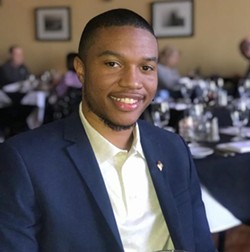IF YOU want to encourage and empower people to become more physically active and improve the health of entire neighborhoods, Armand Turner is your man.
“You really have to figure out what people enjoy doing already and then give them the opportunity and tools to do it more consistently,” he said.
It’s an approach he first learned as a summer camp counselor in Indiana and later working as the head of the recreation and intramural sports department of Albany State University.
Today Turner is managing the physical activity component of a $3.4 million Centers for Disease Control grant awarded to Healthy Savannah through the YMCA of Coastal Georgia. The funding from the CDC’s Division of Nutrition, Physical Activity, and Obesity is aimed at reducing health disparities among racial and ethnic populations with the highest burden of chronic disease using culturally tailored interventions to address preventable risk behaviors. Savannah is one of 31 communities nationwide to receive a Racial and Ethnic Approaches to Community Health grant.
Healthy Savannah will use the funding to reduce health disparities among African American and Hispanic/Latino Americans in low income areas of Chatham County by improving access to healthy food and opportunities for physical activity, and creating more effective links between people in need and the clinical service providers and organizations that can help.
Turner sees the REACH grant fitting into a larger context.
“It seems as if a lot of things are lining up for Savannah to be one of the healthiest cities in the South, between the coalition of health organizations looking to deconstruct old habits of unhealthy living to opportunities to make healthier choices easier for citizens through the new zoning ordinance. Savannah has the chance to flip the switch and it’s sitting right in front of us,” he said.
In order to flip that switch, especially when it comes to encouraging physical activity, barriers must be overcome.
“In the hierarchy of ‘reasons not to do anything,’ personal safety will always be at the top,” he said. “No one wants to ride a bike if they think they’re more likely to get in an accident, than to get where they’re going.”
Turner said improving safety is key to encouraging people to bike and walk for recreation and transportation.
“I think that’s exactly where Tide to Town comes in,” he said, describing the proposed 30-mile network of trails and other infrastructure. “Trails and protected bike lanes allow those who really do need and want to walk and ride, to do so. And bring their kids! And not worry about anyone getting hurt in the process.”
The return on investment in trails, sidewalks, and bike lanes is evident, as is demand.
“The health benefits are well documented and we know it’s something many Savannahians want,” he said.
Yet some aspects of cycling in Savannah are not widely recognized, Turner said.
“What’s often unnoticed is that many African Americans are cyclists. Many for recreation and many as their sole form of transportation to everyday destinations, such as work or the grocery store,” he said.
“It’s important for those individuals to have a safe means to walk or bike and we believe Tide to Town can provide that. We want all of our neighborhoods to have access to this trail.”
Turner said he is firmly committed to giving voice to community members, who have been overlooked in the past. He is working to ensure they are able to stay in their communities once improvements are in place. That’s why he’s particularly interested in NewZO as a means to prevent gentrification and displacement.
“We’ll work with our neighborhoods and see increased physical activity and better eating habits across the board.” he said.
While planning and building infrastructure is often a long process — note the long-awaited construction of the Truman Linear Park Trail finally underway now — Turner is undertaking more immediate efforts, such as coordinating “Walking School Bus” initiatives in public housing communities. A walking school bus is a group of children walking to school with one or more adults.
“Encouraging our younger generation to see walking as a viable means of transportation is essential to instilling a new, healthier mindset for the future,” Turner said.
He has an ambitious vision for when the REACH grant concludes and beyond.
“I hope at the end of the grant period Savannah becomes the blueprint for every other city in the South looking to change its unhealthy ways and support health equity for their African-American and Hispanic populations, who for so long have not received needed resources to succeed.”
And even further than that.
Turner said, “To know that we’ve jumpstarted a trend of healthier living for individuals, who are often denied equity in that area, is something I know I can be proud of for a lifetime.”


